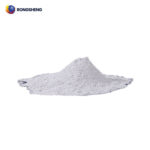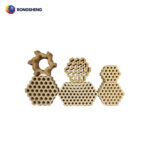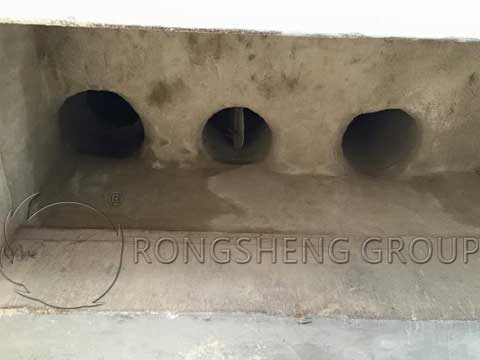Cause Analysis and Preventive Measures for Castable Material Falling and Damage in Cement Kiln Preheater
Monolithic castable refractory are widely used in high-temperature industries due to their short production cycles, ease of construction, and ease of repair. They are the most common monolithic refractory material. During cement production, raw material impurities and the use of waste co-processing technologies lead to the contamination of cement kilns with harmful elements such as potassium, sodium, sulfur, chloride, and phosphorus. These elements circulate and accumulate within the system, potentially entering the castable through pores and cracks on the surface, where they accumulate in liquid or solid form and damage the castable’s interior.
After one year of operation, a cement company experienced extensive damage to the castable at the top of the C5 cyclone in the preheater. This caused blockage in the discharge pipe and forced the kiln to shut down for repairs. The monolithic castable refractory recovered on-site showed high strength, no obvious signs of surface corrosion, and minimal wear. However, the internal anchors showed significant corrosion. To address this phenomenon, this paper analyzes and experimentally validates the factors influencing castable properties, anchor failure, and quality control and production operations during construction.
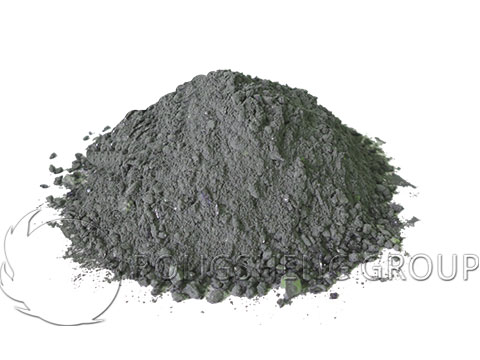
Castable Shedding
The preheater anchors and refractory material of the preheater cyclone cover on this production line are designed to be high-strength, alkali-resistant castables. After one year of operation, the castables at the top and cone of the preheater C5 cyclone began to shed in chunks, causing blockage in the feed pipe. On-site photos show no obvious signs of wear or corrosion in the working layer of the castable, but the anchors within the castable have suffered severe corrosion. The corroded areas are yellow-green in color, with some areas appearing dark brown. The corrosion is most severe at the anchor heads. Corrosion products on the anchor surfaces show distinct stratification, and the surface layer is relatively loose. Corrosion products that have detached from the anchor surfaces have adhered to the bond between the monolithic castable refractory and the anchor.
Physical and chemical analyses and tests were conducted on samples collected from the site, including castable lining remnants, anchors (including used ones), and cement clinker, to identify the cause of the monolithic castable refractory shedding damage.
Analysis of Causes of Castable Shedding
Casable Properties
High-Temperature Performance of Castable and Anchors at Different Temperatures
To investigate whether changes in castable and anchor properties within the actual operating temperature range of the preheater could lead to the monolithic castable refractory shedding, high-temperature performance tests were conducted at different temperatures.
Casable test specimens were accurately weighed according to inspection specifications, mixed thoroughly, and then stirred with water. The specimens were then vibrated and formed. During the forming process, unused anchors returned from the site were embedded within the monolithic castable refractory to create the test specimens. The specimens were naturally cured for 24 hours before being demolded. After demolding, the specimens were placed in a constant-temperature drying oven at 110°C for 24 hours. The dried specimens were then heated at 900°C, 1150°C, 1200°C, and 1250°C for 3 hours, followed by natural cooling. The specimens were then cut open and inspected.
Cross-sectional morphologies of the contact area between the monolithic castable refractory and anchors after holding for 3 hours at four temperature ranges show that, after treatment at 900°C, neither the anchors nor the castables exhibited oxidation, corrosion, or other changes in the absence of alkali salt attack. This indicates that the structure and performance of the anchors and castables were unaffected at this temperature. When the holding temperature was increased to 1200°C, a glaze-like substance began to appear on the castable surface, while the anchors within did not experience any corrosion related to high-temperature melting. As the holding temperature increased to 1250°C, a large amount of liquid phase appeared on the castable surface, but no significant changes were observed within the castable. This surface liquid phase is due to oxidation of silicon carbide in the castable at this temperature, while the anchors embedded within the castable did not experience any significant corrosion.
The temperature of the fifth stage of the preheater is typically between 850 and 1000°C. Based on these test results and comparison with the cross-sectional morphology of the castable lining remnants that fell off in-situ, it can be concluded that the in-situ monolithic castable refractory performed normally during its service life.
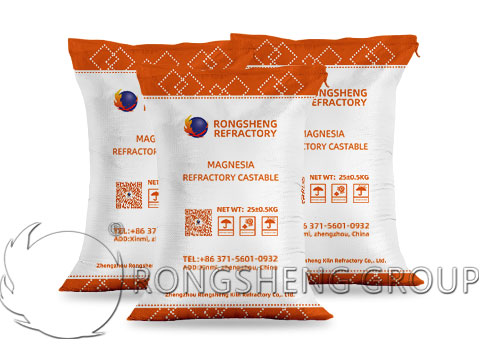
Effect of Water Addition on Castable Properties
Samples were accurately weighed and mixed, then stirred at water addition rates of 6%, 7%, 8%, 9%, and 10%. Vibration molding was performed to produce specimens measuring 40 mm × 40 mm × 160 mm. Cured naturally for 24 hours before demolding. The specimens were then placed in a constant-temperature drying oven and held at 110°C for 24 hours. The specimens were then fired to 1100°C and held for 3 hours before cooling naturally. All heat-treated specimens were tested for bulk density, apparent porosity, room-temperature compressive strength, and room-temperature flexural strength according to relevant standards. Physical and chemical analysis was also performed on the castable linings retrieved from the project site.
This analysis revealed that increasing the amount of water added significantly decreased the compressive and flexural strength after firing at 1100°C, while increasing the apparent porosity and decreasing the bulk density. This indicates that water addition significantly influences the various properties of the monolithic castable refractory and that it should be properly controlled during construction. Good construction quality can significantly reduce the apparent porosity of the castable, helping to isolate harmful elements from contact with the anchor surface, slowing corrosion and extending the service life of the castable.
In addition, layered cutting of the castable lining revealed a very low apparent porosity, ranging from 0.4% to 2.9%. This strongly demonstrates that the castable has been subjected to high levels of alkali salt penetration during use. Harmful elements have penetrated into the monolithic castable refractory through the pores, reacting with the anchor during use and accelerating anchor corrosion.
Construction Quality Inspection
During construction, the production line was constructed in blocks of 1.5 to 2 m². Anchor welding, expansion joint preparation, castable water addition, and vibration were all inspected and verified by professionals, demonstrating a standardized and rational construction process. Furthermore, the removed castable material appeared to be intact and high-strength, with no delamination observed during construction. Anchors cut from the site showed intact welds between the anchors and the shell steel plate, indicating that the fracture originated from the anchors themselves. This ruled out any issues with the on-site welding quality of the anchors.
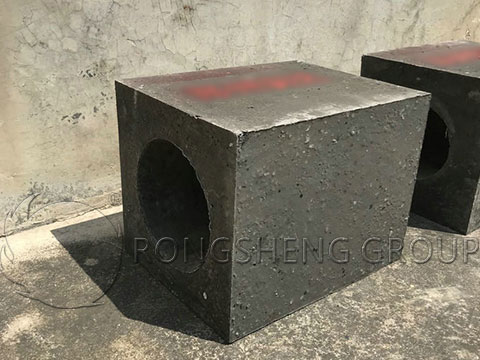
Anchor Analysis
Chemical composition testing was performed on the anchors retrieved from the site, including those after use. The test data revealed that the sulfur and phosphorus contents of the used anchors were increased by 77 times and 56 times, respectively, compared to unused anchors. This indicates that the used anchors were subject to significant corrosion and penetration by sulfur- and phosphorus-containing substances.
In addition, a yellow-green substance was detected at the contact area between the castable lining and the anchors. This substance is likely due to the presence of chromium in the anchors. In a high-temperature oxidizing atmosphere, surface-deposited sulfur, chlorine, or phosphorus-containing salts react chemically with the surface oxide film, forming yellow-green chromium salt compounds.
Based on the remaining state of the anchors at the site and analysis of their chemical composition, it can be preliminarily determined that the damage to the anchors was primarily due to high-temperature corrosion caused by sulfur, phosphorus, and chlorine, which led to metal corrosion and failure.
Analysis of Operational Processes
Physical and chemical testing of cement clinker retrieved from the site revealed that the K₂O, Na₂O, and Cl content of the clinker from this production line was comparable to domestic clinker, but the SO₃ and P₂O₅ contents were higher, increasing by 3 and 2.8 times, respectively. This production line lacks a bypass ventilation system, leading to the circulated accumulation of sulfur and chlorine at the kiln tail. It is foreseeable that these high concentrations of sulfur and chlorine accumulate in the kiln tail, seeping into the castable and corroding the anchors at high temperatures.
Based on the above analysis, the cause of castable shedding in the preheater of this cement kiln can be ruled out as a result of monolithic castable refractory quality and construction factors. During the dry cement production process, significant circulated accumulation of sulfur, chlorine, and phosphorus occurs at the kiln tail. These harmful elements corrode and damage the anchors, reducing their anchoring performance and ultimately leading to castable shedding and damage.
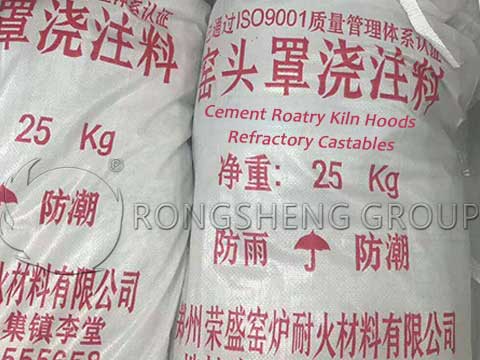
Preventive measures for refractory material shedding
(1) According to the content of harmful elements in different raw materials, select appropriate anchor material and specifications in technical design.
(2) From the production perspective, control the circulation degree of harmful volatile components such as alkali, chlorine, and sulfur in the kiln to reduce the equilibrium concentration of harmful components. Control the sulfur-alkali ratio of clinker, preferably around 0.8 to 1.2, to create conditions for clinker to carry away harmful components.
(3) During the construction of refractory materials, target areas with severe harmful gas erosion. Pay attention to the gaps in the working surface, reasonably set expansion joints, and reasonably select expansion joint filling materials to prevent gas short-circuiting into the interior of the lining. Strengthen construction process control, reduce the porosity of the material, and prevent harmful gas penetration and erosion.
(4) During the ignition and heating process, strictly control the heating rate and adhere to the principle of “slow heating without turning back” to avoid rapid heating of refractory materials during the heating process, which may cause the monolithic castable refractory to burst.
Conclusion
Currently, some cement kilns inevitably use raw materials high in harmful components, which increases the workload of refractory materials and reduces their service life. However, by analyzing the operating conditions of cement kiln systems and incorporating the different mechanisms of refractory material failure, appropriate anchors, suitable refractory materials, and standardized construction techniques can be selected. Furthermore, by implementing appropriate process optimization measures, the service life of refractory castables can be effectively extended, laying the foundation for stable kiln system operation and achieving high-quality, high-yield production.

